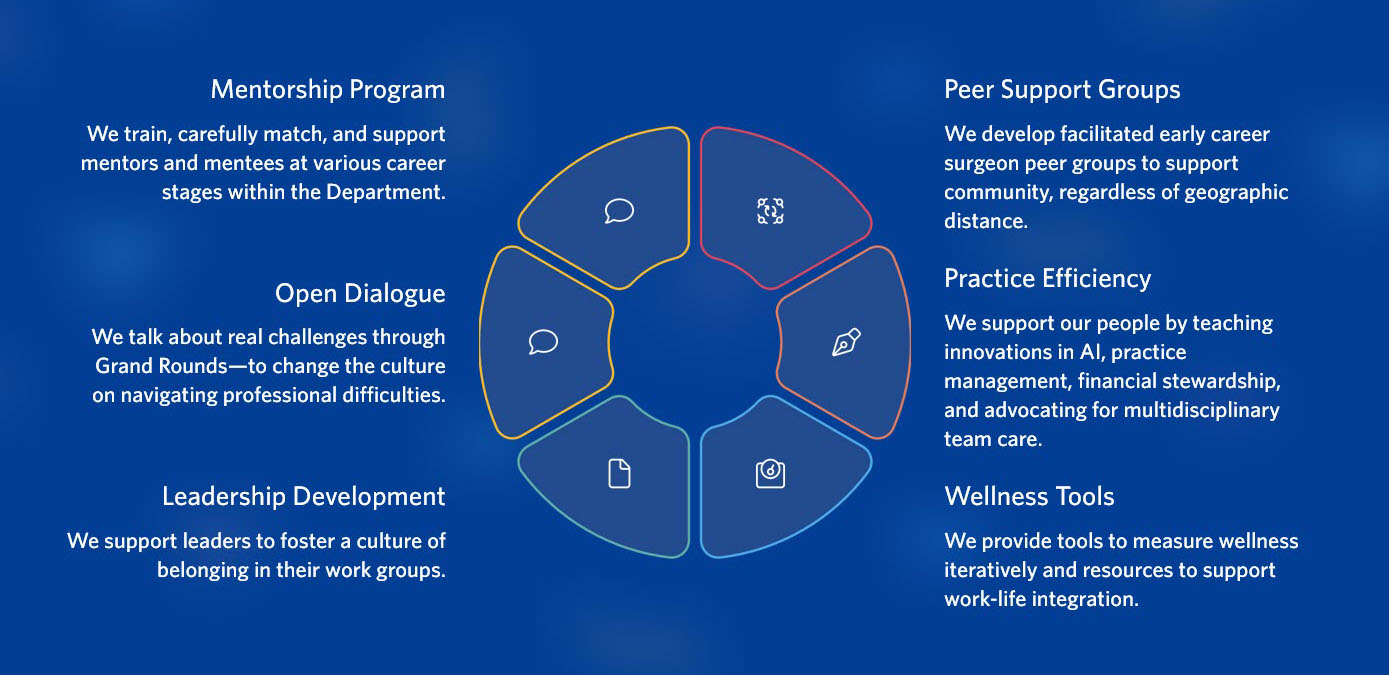Why wellbeing is important for the Department of Orthopaedics.

This article was written as part of an ongoing series to highlight the 13 factors of a Psychologically Healthy and Safe workplace: Organizational Culture.
We spoke with Dr. Carrie Kollias, Co-Director of Mentorship & Wellness for the Department of Orthopaedics to understand how changing the culture and centering wellbeing can lead to sustainable excellence for organizations, individuals, teams, and those they serve.
As Canadian patients continue to face critical wait times as a result of a national shortage of orthopaedic access, this is taking a toll on orthopaedic clinicians as well. UBC’s Department of Orthopaedics is responding with a transformative, human-centered approach: its Mentorship & Wellness Initiative.
“The unique needs of orthopaedic surgeons often go unrecognized—yet our field is high volume, physically intense, and emotionally draining in the context of limited patient access,” says Dr. Carrie Kollias, Co-Director of Mentorship & Wellness. “Canada has the lowest number of orthopaedic surgeons per capita among G7 nations—just 3.5 per 100,000 people. Our patients face the longest pretreatment wait times of any specialty. That access shortage takes a toll on both patients and providers.
“For orthopaedics, investing in wellbeing isn’t just about preventing surgeon burnout—it’s about enabling long-term excellence for our teams and fulfillment in our practice.”
Deep connections
Recognizing the moral distress surgeons face when they’re overworked and lacking the necessary resources to provide timely care, the department launched its Mentorship & Wellness Initiative in 2024. The unique challenges facing orthopaedic surgeons require unique interventions. That is why the department is focused on uplifting its doctors through inspiring mentorship.
The Department have selected the Stanford WellMD model for their wellbeing strategy.
The Stanford WellMD model emphasizes three foundational pillars: Culture of Wellness, Efficiency of Practice, and Personal Resilience. These foundational elements are being integrated into every aspect of the department’s mentorship, professional development, and informal peer support systems.
This model expands well past formal mentorship to broader interventions that address culture, systems, and meaningful connection at every level of career development.
Maintaining momentum
To this end, the Department of Orthopaedics is building momentum toward a more connected professional environment that expands across the province to many distributed sites, providing support to early-career surgeons. Looking ahead, the Department will continue to expand mentorship matches, support peer-led networks and support groups, provide leadership training, and deepen awareness in its members and support evaluation efforts using fulfillment and burnout tracking tools.
“We’re just getting started,” says Dr. Kollias. “Our vision is to build a department where every orthopaedic professional—from medical students, researchers, and support staff to emeritus faculty—feels connected, supported, and professionally fulfilled.”

The work of embedding wellbeing into organizations is constantly evolving. “Ten years ago, we didn’t even know what the term wellbeing meant in orthopaedics.” Dr. Kollias reflects, “That’s changed. We know that over 50% of Canadian Orthopaedic Surgeons are burned out, so when it’s the majority, the stigma is shattered. Brave surgeons are now sharing their stories, working through hard things, and building a culture of generosity to support the next generation.”
Wellbeing at UBC
UBC’s Health, Wellbeing & Benefits (HWB) team continues to explore how wellbeing can be meaningfully integrated into the higher education workplace. Their approach aligns with efforts in the Department of Orthopaedics, where psychosocial safety considerations are being actively addressed. Over time, the HWB team has found that embedding wellbeing is most effective when resources and guidance are tailored to individuals, teams, and their unique environments. Dr. Kollias’ work exemplifies this: customizing wellbeing strategies to fit each community can lead to positive shifts in organizational culture.
Wellbeing is a strategic priority and also takes a concerted effort over many years to progressively weave it into day-to-day operations, leadership development, workplace practices, and the provision of support. Culture change occurs with a deep understanding and passion for improving the lives of those in our teaching, learning and workplace environments. Dr. Kollias and her team demonstrate this approach.
If you are looking for support and guidance in your efforts to create a thriving environment and embed wellbeing practices into your faculty or department, please consider a consultation with the Workplace Wellbeing team. And if you are looking for more resources and support for teams and departments, take a look at our Workplace Wellbeing Programs or our Mental Health resources page for more individual options.
Posted in Articles
Tagged
- HR
- Healthy UBC